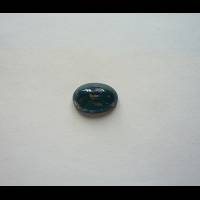Covellite

DR Congo
8.90 carats
© Giovanni Scapin 2015
Covellite forms opaque masses with vivid iridescent blue colours.
Massive material can be cut into brilliant blue cabochons.
| General Information | |||||||||||||||||||
|---|---|---|---|---|---|---|---|---|---|---|---|---|---|---|---|---|---|---|---|
| Chemical Formula |
| ||||||||||||||||||
| Physical Properties of Covellite | |||||||||||||||||||
| Mohs Hardness | 1.5 to 2, Handbook of mineralogy (2001) More from other references | ||||||||||||||||||
| Specific Gravity | 4.6 to 4.76, Handbook of mineralogy (2001) More from other references | ||||||||||||||||||
| Tenacity | Flexible, Handbook of mineralogy (2001) Flexible in thin leavesMore from other references | ||||||||||||||||||
| Cleavage Quality | Perfect, Handbook of mineralogy (2001) More from other references | ||||||||||||||||||
| Fracture | Uneven, Gemstones (2009) | ||||||||||||||||||
| Optical Properties of Covellite | |||||||||||||||||||
| Refractive Index | 1.45 to 2.62, Gemstones (2009) | ||||||||||||||||||
| Optical Character | Uniaxial/+, Handbook of mineralogy (2001) More from other references | ||||||||||||||||||
| Birefringence | 1.17, Gemstones (2009) | ||||||||||||||||||
| Pleochroism | Marked, deep blue to pale blue., Handbook of mineralogy (2001) | ||||||||||||||||||
| Dispersion | Strong, Handbook of mineralogy (2001) | ||||||||||||||||||
| Colour | |||||||||||||||||||
| Colour (General) | Indigo-blue or darker, commonly highly iridescent, brass-yellow to deep red., Handbook of mineralogy (2001) More from other references | ||||||||||||||||||
| Causes of Colour | Blue and orange pleochroism, Band theory, Pragmatic Spectroscopy For Gemologists (2011) | ||||||||||||||||||
| Transparency | Opaque, Handbook of mineralogy (2001) More from other references | ||||||||||||||||||
| Lustre | Resinous,Pearly,Dull (Earthy),Submetallic, Handbook of mineralogy (2001) Submetallic, inclining to resinous, somewhat pearly on cleavage; subresinous to dull when massive.More from other references | ||||||||||||||||||
| Crystallography of Covellite | |||||||||||||||||||
| Crystal System | Hexagonal, Handbook of mineralogy (2001) More from other references | ||||||||||||||||||
| Habit | Forms hexagonal plates as large as 10 cm, flattened, which may exhibit hexagonal striae; as rosettes of nearly parallel plates; commonly massive and foliated., Handbook of mineralogy (2001) More from other references | ||||||||||||||||||
| Geological Environment | |||||||||||||||||||
| Where found: | Occurs in the secondary enrichment zones of copper deposits., Gems, Sixth edition (2006) More from other references | ||||||||||||||||||
| Further Information | |||||||||||||||||||
| Mineral information: | Covellite information at mindat.org | ||||||||||||||||||
| Significant Gem Localities | |||||||||||||||||||
| |||||||||||||||||||
